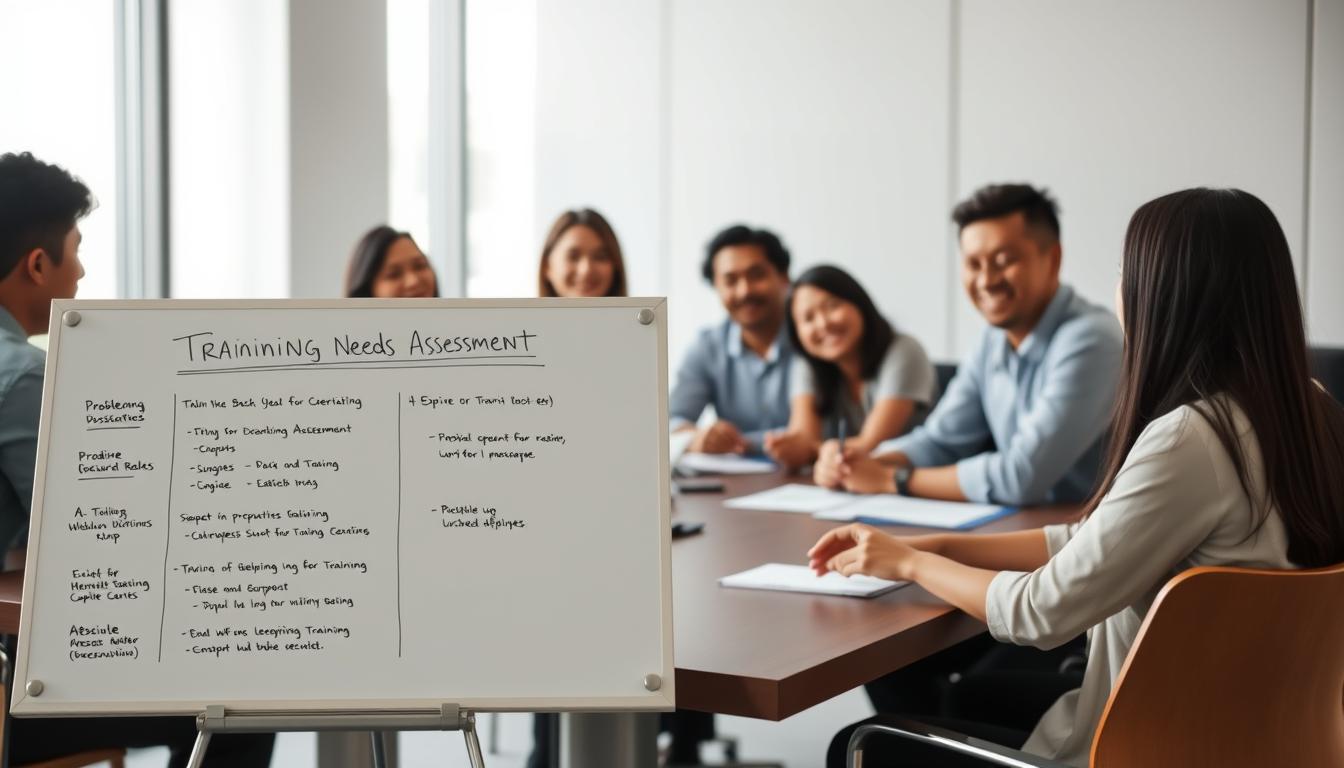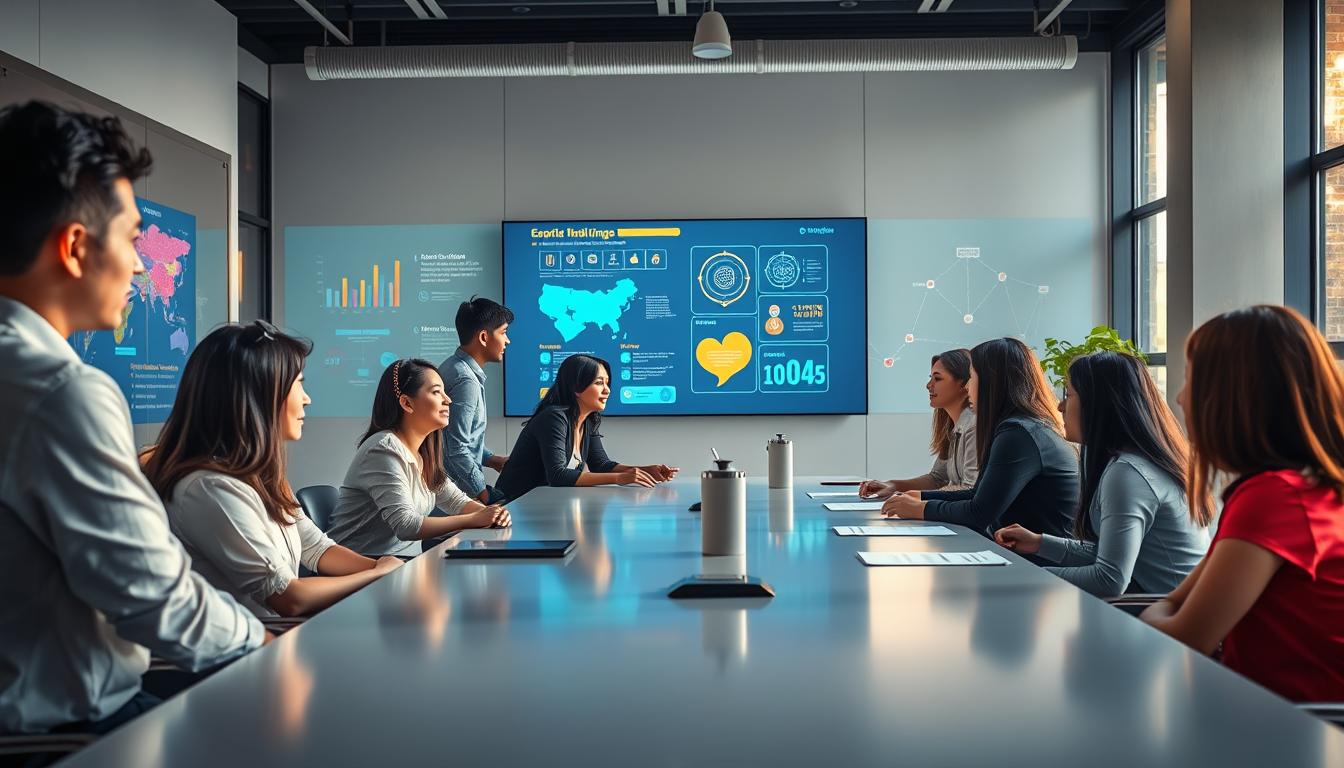What if your company’s success depended on how well you train your teams? In small and medium enterprises in the Philippines, training is key. It boosts employee performance, mainly in HR, IT, and finance.
Training is often seen as just a step, but it’s crucial for success. By creating training that fits each team’s needs, companies can improve performance. This article will show you how to make training impactful. It will help your teams overcome challenges and succeed.
Key Takeaways
- Understanding the importance of tailored training for specific departments.
- Identifying employee needs to foster effective training sessions.
- Developing training plans that align with organizational goals.
- Utilizing visual aids and real-life examples for engaging content.
- Collecting feedback to evaluate and improve training effectiveness.
Understanding the Importance of Effective Training Sessions
Training sessions are key to employee growth and a company’s success. They are crucial in HR training, helping employees gain vital skills. Good training boosts individual skills and supports the company’s goals.
Studies show that good training leads to better employee productivity. In the Philippines, big companies like Ayala Corporation and PLDT focus on employee growth. They believe in ongoing learning and skill improvement.
A well-planned training session makes employees feel important and supported. It shows a company cares about its workers’ growth. This leads to a happier and more productive team.
Identifying the Specific Training Needs of Employees
It’s key to know what training employees need to do better. A detailed training needs assessment shows what skills are missing. Employee surveys are a good way to find out what skills they want to learn.
Looking at how well employees do their jobs helps too. This lets companies spot where they need to improve. Feedback from managers is also important. They know what’s working and what’s not.
Watching employees do their jobs can reveal skills gaps. This hands-on method shows where they need help. Training that’s tailored to these needs keeps learning relevant and helps meet company goals. For Filipino SMEs, this is crucial to stay ahead and improve employee skills.
| Assessment Method | Description | Benefits |
|---|---|---|
| Employee Surveys | Gathering input from employees about their desired skills and perceived gaps. | Direct insights from employees on their training preferences. |
| Performance Data Analysis | Reviewing metrics related to employee performance and productivity. | Identifies specific areas needing improvement. |
| Supervisor Feedback | Insights from supervisors regarding employee performance and potential. | In-depth understanding of team dynamics and issues. |
| Observation | Monitoring employees during their work to assess practical skills. | Real-time identification of skills gaps and training opportunities. |
Developing a Training Plan that Aligns with Organizational Goals
Creating a good training plan means understanding the organization’s goals. It makes sure training improves skills and helps the company do better. Setting clear learning goals is key to guide trainers and learners.
Setting Clear Learning Objectives
Learning objectives are essential in a good training plan. They should be specific, measurable, achievable, relevant, and time-bound (SMART). This helps focus efforts and resources.
For example, if a finance team learns new software, the goal might be to master key functions quickly. This makes it clear what to focus on during training.
Conducting Needs Assessment through Surveys and Feedback
Understanding what employees need is crucial for effective training. Surveys and feedback help identify skills gaps and preferences. This information makes the training plan better for everyone.
For instance, if IT says they need cybersecurity training, it can be added to the plan. This supports safety and compliance in the workplace.
Designing Engaging Training Materials
Creating engaging training materials is key to keeping participants interested. Visual aids like charts and videos help them understand better. Interactive content, such as quizzes and group activities, makes learning fun and interactive.
Utilizing Visual Aids and Interactive Content
Visual aids make complex information simple. They break down content into easy-to-digest pieces. Interactive content, like polls and scenarios, creates a lively learning environment.
This mix boosts retention and encourages deeper learning. It helps participants process information better.
Incorporating Real-Life Examples Relevant to Philippine Companies
Using real-life examples from Philippine companies makes learning more relatable. For example, Globe Telecom uses training modules that show how theories work in practice. This approach makes learning more relevant and effective.
It helps participants see how what they learn applies to real-world situations. This makes the learning experience more impactful.
Conducting Training Sessions Effectively
To do well in training sessions, you need to plan carefully and use different ways to keep people interested. Start by setting clear goals and making sure everyone knows what’s expected. Use interactive tools like discussions, activities, and stories that fit the workplace.
When it comes to HR training, hands-on activities help people learn and remember better. Team projects teach teamwork and how to apply what you’ve learned. Keeping things fun and interactive keeps everyone excited to learn.
Trainers should try different methods to meet the needs of their audience. Using visual aids and technology can make learning more exciting. This way, training becomes more than just a class; it’s a memorable experience for everyone.
For more tips on making training programs engaging, check out effective HR training resources. They offer tools to make learning more adaptable and reflective.
Training & Adoption: Ensuring Employee Engagement
It’s key to keep employees engaged for good training and adoption. Interactive training turns boring sessions into fun experiences. Activities like role-plays and team exercises get everyone involved.
This approach not only improves learning but also builds teamwork. It helps team members connect better.
Implementing Interactive Training Techniques
Interactive training boosts learning. Here are some ways to do it:
- Group discussions for different views
- Simulations to practice real scenarios
- Quizzes and games to make learning fun
These methods keep employees interested and involved in their learning.
Encouraging Open Communication During Sessions
Good communication makes training better. When everyone feels free to ask and share, learning gets richer. Employers in the Philippines can help by:
- Setting clear expectations for participation
- Welcoming feedback on training
- Listening to employees’ concerns and ideas
By valuing open talk, employers show how much they value employee engagement. This makes every training session a team effort towards growth.
Evaluating the Effectiveness of Training Sessions
It’s key to check if training sessions are working well. Companies can do this by using good ways to check how training goes. They look at what people say and how much they learn to see if training is helping.
Collecting Feedback from Participants
Getting what people think is very important. Surveys and talks help find out if training is good. Here’s how to get useful feedback:
- Pre-training surveys to see what people know first.
- Post-training questionnaires to check if they’re happy and if it was useful.
- Focus group discussions to really get into what people thought.
Analyzing Learning Outcomes and Performance Improvements
After getting feedback, it’s time to see if learning has improved. This means looking at how well people do their jobs after training. For example, companies might look at things like:
| Training Topic | Initial Performance (%) | Post-Training Performance (%) | Improvement (%) |
|---|---|---|---|
| Budget Management | 65 | 85 | 20 |
| Risk Assessment | 70 | 90 | 20 |
| Data Analysis | 60 | 80 | 20 |
This way of checking training helps see if it’s really helping the company meet its goals.
Making Adjustments for Future Training Workshops
Improving training is an ongoing task. After each session, trainers collect feedback to see what works and what doesn’t. They make changes for the next workshops to meet the needs of everyone involved.
For companies to stay ahead, they must always be improving. Trainers look at how things went and what people said. This helps them make better training that everyone can use.
Small and medium-sized businesses face big challenges in keeping up with trends. By always listening and changing, they make training better. This leads to a more skilled and happy team.
| Training Session | Feedback Collected | Adjustments Made |
|---|---|---|
| Workshop on Project Management | Need for more interactive activities | Incorporated group exercises and case studies |
| Sales Techniques | Request for role-playing scenarios | Added practical role-playing sessions |
| Software Training | Difficulty understanding complex features | Simplified instructions and added visual aids |
Leveraging Technology in Training Delivery
Using technology in training changes how we learn, making it more dynamic. E-learning platforms have made learning easier than ever. They let employees learn at their own pace, whenever they want.
Exploring E-learning Platforms and Tools
E-learning platforms have many tools to help learning. They include video lectures, quizzes, and games. These make learning fun and engaging.
Platforms like Coursera, Skillshare, and EdX offer courses for specific needs. They use multimedia to meet different learning styles.
Integrating Online and Offline Training Methods
Online and in-person training together make learning better. Virtual workshops teach theory, then in-field training applies it. This mix helps keep information and makes it useful.
Organizations in the Philippines can create great training programs. They use both online and offline methods. This way, they meet different learning needs and improve retention.
| Training Approach | Advantages | Considerations |
|---|---|---|
| E-learning Platforms | Flexible schedule, interactive content, varied resources | May lack hands-on experience, requires self-motivation |
| In-person Training | Direct interaction, practical application, immediate feedback | Less flexibility, potential logistical challenges |
| Hybrid Method | Best of both worlds, higher engagement, encourages application | Requires careful planning, may need additional resources |
Overcoming Common Training Challenges
Training challenges often come up in organizations. They happen because some people don’t want to learn and everyone learns differently. It’s important to understand these issues to make training effective and help everyone grow.
Addressing Resistance to Training Initiatives
Some people don’t want to train because they don’t think it will help them. They might also worry it’s not relevant to their job. To fix this, it’s crucial to talk clearly about why training is important.
Showing how training fits with both personal and work goals helps build trust. When people see the value, they’re more likely to participate.
Managing Diverse Learning Preferences
Everyone learns in their own way. To meet these needs, trainers should mix different teaching methods. This could include pictures, listening, and doing things hands-on.
By using a variety of approaches, everyone can stay interested and learn something. This way, trainers can overcome common training hurdles.
Conclusion
Creating effective training sessions is a journey that needs a deep understanding of both goals and employee needs. By focusing on employee growth and aligning training with company goals, companies can build a more engaged team. This team is ready to face challenges and innovate.
Using engaging materials and interactive techniques makes learning better. It also helps the company succeed. As training becomes a regular part of business, the Philippines will see a culture of learning grow.
By always checking and improving training, companies can keep it relevant and effective. This effort not only helps employees grow but also prepares a brighter future for everyone involved.




